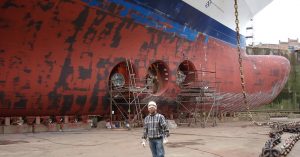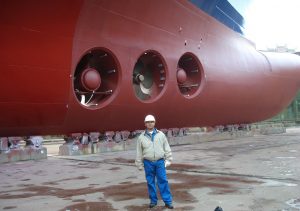Oceans are the lifeblood of planet Earth and humankind. They flow over nearly three-quarters of our planet and hold 97% of the planet’s water. They produce more than half of the oxygen in the atmosphere and absorb the most carbon from it. In short, whatever human beings require to exit, oceans have it all. But with the increase of human activities in oceans has led to hampering the aquatic life to a major extent. The expanded seaborne trade and traffic volume over the last few decades have unintentionally introduced invasive species to new habitats via the ballast water carried by commercial shipping vessels. To our surprise, Ballast water spreads an estimated 7000 living species to new habitats across the globe, because of which the effects in many areas of the world have been devastating. Actually, invasive aquatic species are one of the greatest threats to the world’s oceans. Quantitative data show that the rate of bio-invasions is continuing to increase at an alarming rate and new areas are being invaded all the time.

The actual problem arises when ballast water contains marine life. There are literally thousands of species that may be carried in ships’ ballast – anything small enough to pass through a ship’s ballast water intake pumps. This includes bacteria, small invertebrates and the eggs, cysts, and larvae of various species. These alien species are considered to be invasive when their introduction causes or is likely to cause, harm to the environment, the economy, or human health.
Ballast water impacts the environment when the ballast water is discharged and the organisms are released into new environments. If suitable conditions exist in this release environment, these species will survive and reproduce and become invasive species. In some cases, there is a high probability that the organism will become a dominant species, potentially resulting in:
Major Impacts of Ballast Water Discharge
- The extermination of local species
- Gradually effects native and regional biodiversity
- Adverse effects on public health directly
- Impacts on local economies based on fisheries
- Effects coastal industries that use water extraction
Ballast water not only affects the maritime industry but the lives of everyday citizens as well. As a result, the whole ecosystem is drastically being changed and economic impacts are also a growing concern. In several countries, introduced, microscopic, ‘red-tide’ algae have been absorbed by filter-feeding shellfish, such as oysters. When eaten by humans, these contaminated shellfish can cause paralysis and even death. Studies revealed that in North America, the introduced European Zebra Mussel has infested over 40% of internal waterways and over US$5 billion has been spent on control measures since 1989. The list goes on, hundreds of examples of major ecological, economic and human health impacts across the globe. It is even feared that cholera may be transported in ballast water. There are hundreds of other organisms carried in ballast water that cause problematic ecological effects outside of their natural range around the world. The International Maritime Organization has listed the eleven most unwanted species which are the cause of marine life destruction:
Problematic Species Causing Marine Life Destruction
- Round Goby – Neogobius melanostomus
- Comb Jellyfish – Mnemiopsis leidyi
- Chinese Mitten Crab or Eriocheir sinensis
- Cholera – Vibrio cholerae (various strains)
- Cladoceran Water Flea – Cercopagis pengoi
- Toxic Algae – (red/brown/green tides) (various species)
- North Pacific Seastar – Asterias amurensis
- Zebra Mussel – Dreissena polymorpha
- Asian Kelp Undaria pinnatifida
- European Green Crab – Carcinus maenas
- Spiny Water Flea – Bythotrephes longimanus
The above-mentioned non-native species have exerted significant effects on the aquatic ecosystems, resulting in a fundamental restructuring through changes in habitat, predation impacts, and competition with native species. Non-native species have been recognized as a major driver of ecosystem change and are expected to grow in importance, contributing to species extinction and the deterioration of ecosystem services. Many alien species are unable to adapt to a new environment or are harmless if they do survive, but others pose a threat to native plants and animals. They might:
Effects of Alien Species to the Aquatic Ecosystem:
- Compete with native species for food or habitat
- Alter the habitat in which they live
- Carry diseases or parasites
- Hybridism with native species
- Increase the risk that already threatened species will become extinct, or displace native species from an area
Organizations along with the countries are striving hard to bridge the gap between the public and the maritime industry in advocating for and educating on maritime industry best practices. The international response to ballast water illustrates how the gap between industry regulations and public impact is growing smaller and how cooperation is vital to Save Our Seas. Researches going around worldwide have brought to focus on how the activities at the sea are leading to a massive amount of pollution.
Activities Leading to Ocean Pollution
- 90 % of world international trade tonnage is transported by ship.
- 12 billion tons of ballast waters containing, at any one time, 3,000 marine species are shipped around the world spreading alien and invasive species.
- The Baltic Sea area is known to host about one hundred aquatic alien species.
- More than 50% of packaged goods and bulk cargoes transported by the sea today can be regarded as dangerous or hazardous from a safety standpoint or harmful to the environment according to the criteria set by the International Maritime Organization (IMO).
- Around 70 percent of litter entering the Ocean lands on the seabed while 15 percent on beaches and 15 percent remains floating on the surface.

However, recognizing the possible severity of the ballast water impacts, organizations have taken action by developing guidelines for preventing the introduction of non-native species in the most affected country across the globe. These Acts or Policies are striving hard to minimize the effects of Ballast Water.
Ballast Water Issues by Countries:
New Zealand – The ballast tanks in New Zealand carry animals and plants that kill ecosystems. Ballast tanks are only used in cargo ships there. Ballast water is controlled under the Biosecurity Act 1993.
Peru – A form of cholera, Vibrio cholerae, previously reported only in Bangladesh apparently arrived via ballast water in Peru in 1991, killing more than 10,000 people over the following three years.
United States – Studies suggest that the economic cost just from the introduction of pest mollusks (zebra mussels, the Asian clam, and others) to U.S. aquatic ecosystems is more than $6 billion per year. Congress passed the National Invasive Species Act in 1996 in order to regulate ballast water discharges. The Coast Guard issued ballast water regulations in 2012. Under the authority of the Clean Water Act, the Environmental Protection Agency (EPA) published its latest Vessel General Permit in 2013. The permit sets numeric ballast water discharge limits for commercial vessels. EPA issued a separate permit for smaller commercial vessels in 2014.
Singapore – Among 818 ports in the Pacific region, Singapore alone accounts for an estimated 26 percent of cross-region (long-range) species exchange. Via targeted ballast management on Singapore and a few other “influential” ports, cross-region species exchange to/from the Pacific region can be combinatorial reduced.
The widespread negative effects of ballast water have been headlining maritime industry news, and in response, the IMO has enacted more stringent regulations on how ballast water must be handled by ships. Currently, there are two standards of ballast water treatment, D1 and D2. D1 regulations require ships to discharge ballast water in open seas, at least 200 nautical miles from shore in water that is at least 200m deep. D1 regulations also require ships to carry a ballast water plan on board, detailing how the ship will follow the regulations as well as a record of when ballast water was taken on board, discharged, or treated. Most ships currently operating on the water follow only D1 regulations, but the IMO has implemented a plan to phase all ships to D2 regulations, which are stricter and set limits on the number of specific indicator microbes that can be discharged, by 2024.
Whether you live on the coast or far from it, whether you eat seafood or not, you and the future of all those you love depends on healthy oceans. The diversity and productivity of the world’s oceans is a vital interest for the humankind. Our security, our economy, and our very survival, all require healthy oceans. We hope, recognizing the possible severity of the ballast water impacts, guidelines, regulations and treatments should be strictly followed so that the further effect and introduction of non-native species could be minimized. To survive and prosper, we need healthy oceans.
SUNIL SARANGI BIOGRAPHY

Sunil Sarangi is an experienced Marine Engineer, He has founded Eco Marine, a Ballast Water Treatment Systems Design and consultants’ firm that helps to protect and control aquatic invasive species.
He began working in the Ballast water regulation in the United States in the early 2005’s. He received his bachelor’s degree in Marine Engineering from the Birla Institute of Technology in India in 2004. He also received his Master’s of Science in Ocean Engineering from Florida Institute of Technology at Florida in 2008.
During the past decade, his work has focused upon developing cost-effective methods for reducing the spread of aquatic invasive species, the economic cost of this introduction has been estimated by the U.S. Fish and Wildlife Service at about $5 billion.
His work over the past 10 years can be summarized as covering the following subjects:
- The design and development of Ballast Water Treatment Systems
- Investigations into the effectiveness of techniques and technologies for measuring and reducing aquatic nuisance species.
- As a lead manager, successfully completed more than $40 million USD projects related to Ballast Water Treatment Systems.
Mr. Sunil Sarangi has authored several articles on Marine engineering and Ballast Water Treatment issues and has spoken at numerous symposia and conferences during the past decade.





